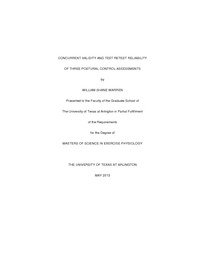
ATTENTION: The works hosted here are being migrated to a new repository that will consolidate resources, improve discoverability, and better show UTA's research impact on the global community. We will update authors as the migration progresses. Please see MavMatrix for more information.
Show simple item record
| dc.contributor.author | Warren, William Shane | |
| dc.date | 2013 | |
| dc.date.accessioned | 2016-01-28T18:03:46Z | |
| dc.date.available | 2016-01-28T18:03:46Z | |
| dc.date.submitted | 2013 | |
| dc.identifier.other | DISS-12216 | |
| dc.identifier.uri | http://hdl.handle.net/10106/25547 | |
| dc.description.abstract | Context: In the United States an estimated 1.6 to 3.8 million sports-related mild traumatic brain injuries occur annually (Broglio, 2008). The accurate and timely diagnosis of concussion using a comprehensive test battery that includes symptom inventories, postural control screening, a physical and neurological screen and a neurocognitive assessment have been recommended. Postural control assessments vary in type, and have a range of reported sensitivities. The Sensory Organization Test (SOT), the Balance Error Scoring System (BESS), and the Stability Evaluation Test (SET) are three measures of postural control. Objective: To determine the test-retest reliability and concurrent validity of three postural control assessments (the Sensory Organization Test [SOT], the Balance Error Scoring System [BESS], and the Stability Evaluation Test [SET]. Participants: Participants consisted of thirty-eight healthy college students (16 male and 22 female) 20 ± 1.6 years of age. Methods Participants were scheduled across four separate time points Day 1, Day 2, Day 45 and Day 50. During day 1 informed consent was obtained and a health history questionnaire was collected, subjects were also familiarized with each test. Approximately 24 hours following the initial appointment each subject returned and was administered the battery of three balance assessments across the remaining three time points. The battery consisted of the NeuroCOM Sensory Organization Test (SOT) the Balance Error Scoring System (BESS) and the Stability Evaluation Test (SET). Main Outcome Measurements: The SOT calculates five composite score: Composite Balance, Somatosensory Input, Vestibular Input, Visual Input and Visual Conflict. The BESS provides a composite error score. The SET provides a composite sway score in degrees per second. Participants were grouped randomly into four groups and given each test in a different order. Repeated Measures ANOVA's were run for each test composite score and condition between each testing period. Post-hoc paired t-tests were used to determine change between time periods. Intraclass correlations were calculated for each test to determine test-retest reliability by comparing scores across each time period. Concurrent Validity was determined by calculating Pearson's r-values for each composite score given by each test.We found each systems composite score to have fair to excellent reliability. The SET ICC values had the strongest reliability scores ranging from .73 to .82, The SOT's composite was found to have fair to excellent reliability with ICC's ranging from .72 to .80. Finally the BESS composite score was found to have fair to excellent reliability with ICC values ranging from .65 to .84 Pearson r correlation coefficients revealed a significant correlation between the SET and BESS (r=. 70) composite scores at the time of baseline. No other significant correlations were observed | |
| dc.description.sponsorship | Resch, Jacob | |
| dc.language.iso | en | |
| dc.publisher | Education | |
| dc.title | Concurrent Validity And Test Retest Reliability Of Three Postural Control Assessments | |
| dc.type | M.S. | |
| dc.contributor.committeeChair | Resch, Jacob | |
| dc.degree.department | Education | |
| dc.degree.discipline | Education | |
| dc.degree.grantor | University of Texas at Arlington | |
| dc.degree.level | masters | |
| dc.degree.name | M.S. | |
Files in this item
- Name:
- Warren_uta_2502M_12216.pdf
- Size:
- 687.5Kb
- Format:
- PDF
This item appears in the following Collection(s)
Show simple item record


